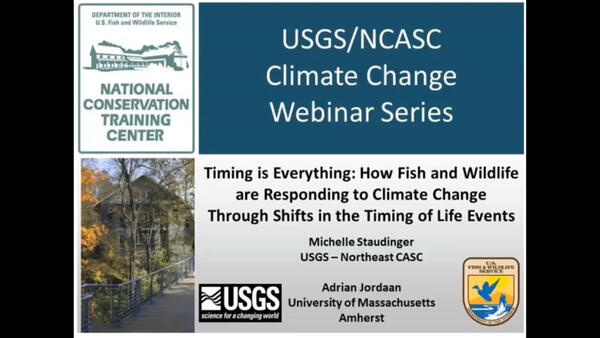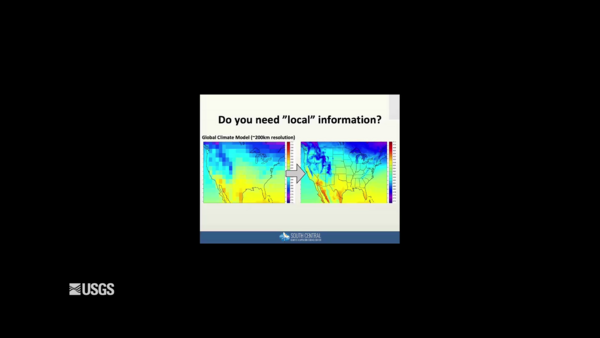Ecosystems are transforming under climate change, with substantial shifts in ecological processes (e.g. fire, landscape connectivity) and important ecosystem services (e.g. pollination, water filtration) occurring at unprecedented rates.
Videos
Climate Champion Video Series
Meet CASC scientists through the USGS Climate Champions video series!
Explore interviews with our scientists, fieldwork videos, and recordings of National CASC-hosted webinars below.
 The RAD (Resist-Accept-Direct) Climate Adaptation Framework
The RAD (Resist-Accept-Direct) Climate Adaptation Framework
Ecosystems are transforming under climate change, with substantial shifts in ecological processes (e.g. fire, landscape connectivity) and important ecosystem services (e.g. pollination, water filtration) occurring at unprecedented rates.
 Developing divergent, plausible, and relevant climate futures for near- and long-term resource planning
Developing divergent, plausible, and relevant climate futures for near- and long-term resource planning
Developing divergent, plausible, and relevant climate futures for near- and long-term resource planning
linkIt seems the effects of climate change were all too clear in 2021. Yet, we know more change is expected. When trying to adapt to a changing climate, with all the inherent uncertainties about how the future may play out, resource managers often turn to scenario planning as a tool.
Developing divergent, plausible, and relevant climate futures for near- and long-term resource planning
linkIt seems the effects of climate change were all too clear in 2021. Yet, we know more change is expected. When trying to adapt to a changing climate, with all the inherent uncertainties about how the future may play out, resource managers often turn to scenario planning as a tool.
 Ridge-to-Reef and Icefield-to-Ocean: Collaborative Research in Extreme Environments
Ridge-to-Reef and Icefield-to-Ocean: Collaborative Research in Extreme Environments
Steep watersheds with dramatic environmental gradients are common features of both the Pacific Islands and Southeast Alaska.
Steep watersheds with dramatic environmental gradients are common features of both the Pacific Islands and Southeast Alaska.
 Setting Habitat Protection and Restoration Priorities in a Warming World: Lessons from Wyoming
Setting Habitat Protection and Restoration Priorities in a Warming World: Lessons from Wyoming
In 2020, the Wyoming Game and Fish Department (WGFD) partnered with the Wildlife Conservation Society (WCS) on a North Central CASC supported project designed to help the agency incorporate climate change into their Statewide Habitat Plan (SHP) that was slated for an update that year.
In 2020, the Wyoming Game and Fish Department (WGFD) partnered with the Wildlife Conservation Society (WCS) on a North Central CASC supported project designed to help the agency incorporate climate change into their Statewide Habitat Plan (SHP) that was slated for an update that year.
 Hawai'i Island: Voices From Community-Based Climate Adaptation
Hawai'i Island: Voices From Community-Based Climate Adaptation
 RAD Framework for Ecosystem Management amid Climate Breakdown (Audio Described)
RAD Framework for Ecosystem Management amid Climate Breakdown (Audio Described)
The Resist-Accept-Direct (RAD) framework is a decision-making tool that helps resource managers make informed strategies for responding to ecological changes resulting from climate change.
The Resist-Accept-Direct (RAD) framework is a decision-making tool that helps resource managers make informed strategies for responding to ecological changes resulting from climate change.
 RAD Framework for Ecosystem Management amid Climate Breakdown
RAD Framework for Ecosystem Management amid Climate Breakdown
The Resist-Accept-Direct (RAD) framework is a decision-making tool that helps resource managers make informed strategies for responding to ecological changes resulting from climate change.
The Resist-Accept-Direct (RAD) framework is a decision-making tool that helps resource managers make informed strategies for responding to ecological changes resulting from climate change.
 Managing Post-Fire, Climate-Induced Vegetation Transitions
Managing Post-Fire, Climate-Induced Vegetation Transitions
Warmer, drier and longer fire seasons in the Northwest have led to larger and more frequent wildfires.
Warmer, drier and longer fire seasons in the Northwest have led to larger and more frequent wildfires.
 Red Devil Cichlid (Amphilophus labiatus) Guarding Habitat
Red Devil Cichlid (Amphilophus labiatus) Guarding Habitat
Multiple stressors such as climate change impacts and invasive species can have compounding impacts on native inland fish.
Multiple stressors such as climate change impacts and invasive species can have compounding impacts on native inland fish.
 Timing is Everything: Fish, Wildlife, and Timing of Life Events
Timing is Everything: Fish, Wildlife, and Timing of Life Events
Timing is Everything: How Fish and Wildlife are Responding to Climate Change Through Shifts in the Timing of Life Events
Timing is Everything: How Fish and Wildlife are Responding to Climate Change Through Shifts in the Timing of Life Events
 Transboundary Connectivity Conservation for a Changing Climate
Transboundary Connectivity Conservation for a Changing Climate
Enhancing ecological connectivity - the degree to which landscapes facilitate the movement of the organisms within them - is a frequently recommended strategy for conserving wildlife populations into the future.
Enhancing ecological connectivity - the degree to which landscapes facilitate the movement of the organisms within them - is a frequently recommended strategy for conserving wildlife populations into the future.
 Coastal Hazard Assessment w/High-Res Data: A Pacific Island Case Study
Coastal Hazard Assessment w/High-Res Data: A Pacific Island Case Study
Low-lying island environments are particularly vulnerable to impacts from coastal hazards, including inundation (coastal flooding), whether the increased water levels are from episodic events (storm surge, wave run-up, king tides) or from chronic conditions (long term sea-level rise).
Low-lying island environments are particularly vulnerable to impacts from coastal hazards, including inundation (coastal flooding), whether the increased water levels are from episodic events (storm surge, wave run-up, king tides) or from chronic conditions (long term sea-level rise).
 Using Decision Tools to Design the Everglades Headwaters NWR
Using Decision Tools to Design the Everglades Headwaters NWR
The U.S. Fish and Wildlife Service’s (FWS) Everglades Headwaters National Wildlife Refuge (EHNWR) is strategically located in Florida to protect upland and wetland habitats.
The U.S. Fish and Wildlife Service’s (FWS) Everglades Headwaters National Wildlife Refuge (EHNWR) is strategically located in Florida to protect upland and wetland habitats.
 Climate Adaptation Planning with Alaska-Based Adaptation Tools
Climate Adaptation Planning with Alaska-Based Adaptation Tools
The dynamic landscape and climate of Alaska presents many challenges to the over 200 communities that live in rural areas of the state and have a wide variety of resource needs. Coastal and riverine erosion, flooding, wildfire, permafrost dynamics and increasing temperatures act as drivers for many of these landscape changes.
The dynamic landscape and climate of Alaska presents many challenges to the over 200 communities that live in rural areas of the state and have a wide variety of resource needs. Coastal and riverine erosion, flooding, wildfire, permafrost dynamics and increasing temperatures act as drivers for many of these landscape changes.
 Sea-Level Rise, El Niño, and Storm Effects on Coastal Tidal Marshes
Sea-Level Rise, El Niño, and Storm Effects on Coastal Tidal Marshes
Tidal marshes exist as a transitional environment between the land and sea, and provides habitat to fish and wildlife, protects human developments from coastal flooding, and stores carbon at high density, among other important ecosystem services.
Tidal marshes exist as a transitional environment between the land and sea, and provides habitat to fish and wildlife, protects human developments from coastal flooding, and stores carbon at high density, among other important ecosystem services.
 Climate Projections as a Way to Illustrate Future Possibilities
Climate Projections as a Way to Illustrate Future Possibilities
This video is a recording of the webinar “Climate Projections as a Way to Illustrate Future Possibilities" that is part of the USGS National Climate Adaptation Science Center (NCASC), in partnership with the National Conservation Training Center (NCTC), 2019 webinar series.
This video is a recording of the webinar “Climate Projections as a Way to Illustrate Future Possibilities" that is part of the USGS National Climate Adaptation Science Center (NCASC), in partnership with the National Conservation Training Center (NCTC), 2019 webinar series.
 Tribal Resources for Climate Change Vulnerability Assessments
Tribal Resources for Climate Change Vulnerability Assessments
Tribes have been actively engaged in efforts to anticipate and respond to climate impacts on their natural and cultural resources.
Tribes have been actively engaged in efforts to anticipate and respond to climate impacts on their natural and cultural resources.
 Variable Warming Upper Midwest Lakes and Implications for Sport Fish
Variable Warming Upper Midwest Lakes and Implications for Sport Fish
Climate change is predicted to alter sport fish communities in Midwestern lakes, but managers currently have limited information on individual lakes that can be used to set local expectations or intervene with mitigation strategies.
Climate change is predicted to alter sport fish communities in Midwestern lakes, but managers currently have limited information on individual lakes that can be used to set local expectations or intervene with mitigation strategies.
Forests around the world are experiencing increasingly hot and severe drought conditions, and drought severity is expected to increase as temperatures rise in coming decades, particularly in the already hot and dry Southwest U.S.
Forests around the world are experiencing increasingly hot and severe drought conditions, and drought severity is expected to increase as temperatures rise in coming decades, particularly in the already hot and dry Southwest U.S.
Biography of scientist featured in Circular 1443 about STEM and related careers in USGS, to be used for recruitment into STEM careers.
Biography of scientist featured in Circular 1443 about STEM and related careers in USGS, to be used for recruitment into STEM careers.
 Aquatic Ecosystem Vulnerability to Fire and Climate Change
Aquatic Ecosystem Vulnerability to Fire and Climate Change
Fire is the dominant ecological disturbance process in boreal forests (coniferous forests consisting mostly of pines, spruces, and larches) and fire frequency, size and severity are increasing in Alaska owing to climate warming.
Fire is the dominant ecological disturbance process in boreal forests (coniferous forests consisting mostly of pines, spruces, and larches) and fire frequency, size and severity are increasing in Alaska owing to climate warming.



